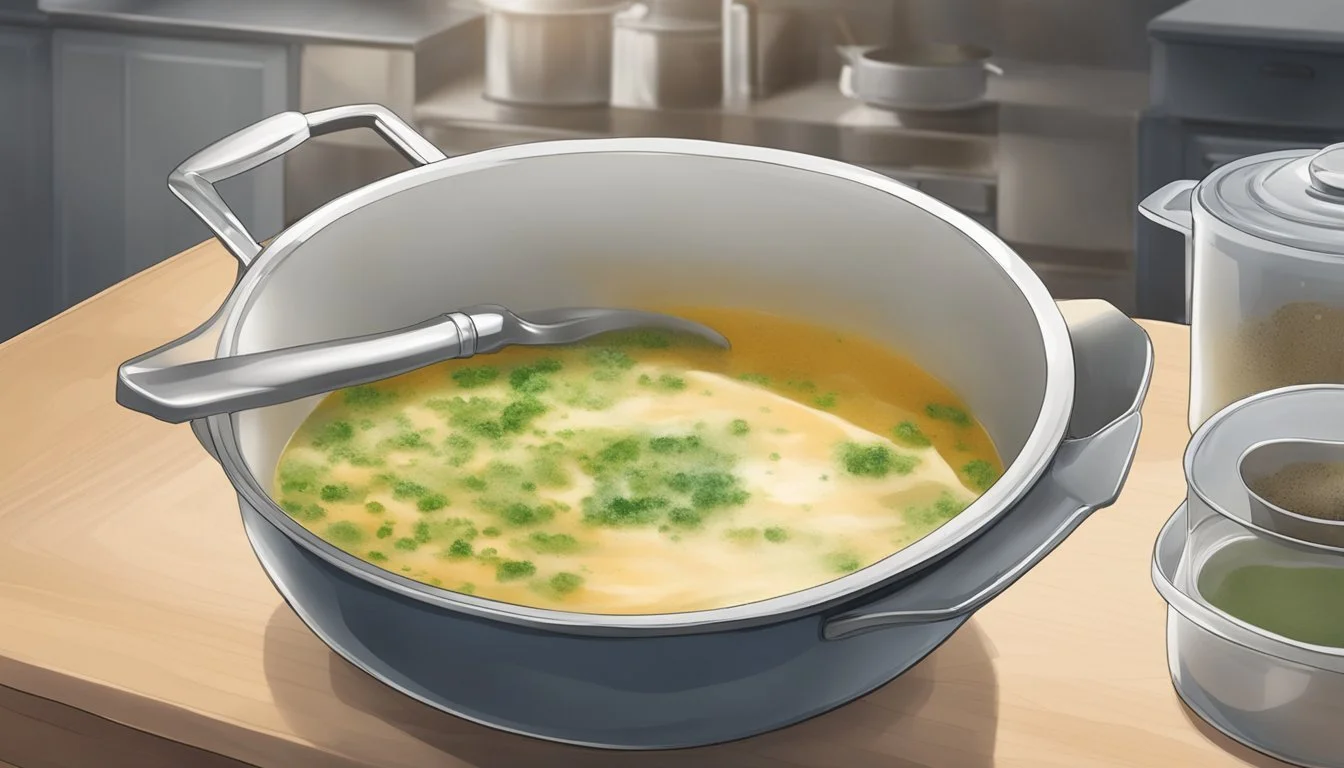Does Soup Base Go Bad?
Shelf Life and Storage Tips
Many home cooks have found themselves questioning whether their soup base or bouillon cubes have gone bad. The answer is not always straightforward due to varying factors like ingredients and storage conditions. Powdered soup bases and bouillon cubes generally have a long shelf life, often extending beyond their printed expiration dates, provided they are stored properly.
Different types of soup bases, such as those containing oils or fats, may spoil faster due to the oxidation of these ingredients. Storing these soup bases in a cool, dry place can extend their shelf life significantly. For powdered broth bases, moisture is the enemy, so keeping them in an airtight container is essential.
While an old soup base might not pose a safety risk, its flavor can degrade over time. Heat and light can accelerate this process, so proper storage is key to maintaining both the safety and quality of the product. Readers looking to get the most out of their soup bases will find practical storage tips and insights in the following sections.
Understanding Soup Bases
Soup bases are concentrated flavoring agents that serve as the foundation for soups, broths, and other culinary dishes. They can be designed to complement a wide variety of recipes and are key elements in achieving rich, flavorful results.
Types of Soup Bases
There are various types of soup bases, each with distinct characteristics and uses:
Powdered Soup Bases: These are dry mixes, often made by dehydrating vegetables, meat, and seasonings. They are convenient because they have a long shelf life and are easy to store.
Paste Soup Bases: These come as thick, concentrated pastes made by reducing a mixture of ingredients. They tend to offer more intense flavors compared to powders.
Liquid Soup Bases: Typically found in broth or stock form, these are made by simmering ingredients such as bones, vegetables, and herbs. They are known for adding a deep, rich flavor to soups and stews.
Using different types can influence the texture and taste of the final dish. Homemade versions often involve fresh ingredients, whereas commercial varieties may include preservatives and additional flavor enhancers.
Role in Cooking and Recipes
Soup bases play a crucial role in various recipes by providing a rich starting point for flavor development. They are essential in soups, stews, and even some sauces:
Enhancing Flavor: A good soup base can elevate the flavor profile of a dish by providing a well-rounded backdrop of taste. Whether for a creamy chowder or a hearty stew, the base sets the tone.
Consistency Improvement: Bases help in achieving the desired consistency. For instance, a gelatinous beef base can add a rich, velvety texture to soups.
Versatility: Soup bases can be used in numerous dishes beyond soups. They are often employed in sauces, gravies, and casseroles to boost flavor.
Incorporating a soup base into homemade soup involves careful simmering and seasoning adjustments. Meanwhile, store-bought bases offer convenience for quick meal preparation, aligning well with modern cooking needs.
Signs of Spoilage in Soup Bases
Knowing the signs of spoilage in soup bases can prevent foodborne illnesses and ensure high-quality dishes. Visual changes, odor transformations, and texture modifications are key indicators of a spoiled product.
Visual Indicators
One of the first signs of spoilage in soup bases is a change in color. Fresh soup bases typically have a consistent and recognizable hue, depending on the type, such as golden for chicken base or rich brown for beef base.
Discoloration, such as turning greenish or gray, usually indicates spoilage.
Mold growth is another clear visual sign. Mold can appear in various colors, including white, green, or black, and can form on the surface or around the container’s edges.
Odor Changes
The smell of a soup base can be a telltale sign of spoilage. A fresh soup base has a distinct, savory aroma.
When the smell changes to something sour, rancid, or otherwise unpleasant, it indicates spoilage.
If the soup base has an unusual odor that differs significantly from its original aroma, it's best to discard it. Chemical smells or any off-putting scent means the product is no longer safe to use.
Texture Modifications
Texture is another critical indicator of a soup base's condition. Fresh soup bases have smooth and uniform consistency.
If the texture becomes slimy or develops clumps, it's a sign the product has spoiled. Gelatinous texture changes or separation of ingredients within the base can also be red flags.
Powdered soup bases can clump when exposed to moisture, leading to spoilage. Keeping an eye on these texture changes can help in determining whether a soup base is still safe to use.
By understanding these signs, one can better judge the freshness and safety of soup bases in their pantry.
Factors Affecting Soup Base Shelf Life
The shelf life of soup base can be influenced by several critical factors. Maintaining optimal storage conditions, selecting appropriate packaging, and paying attention to ingredient compositions can all play a role in preventing spoilage and ensuring quality.
Ingredients and Preservatives
Ingredients in a soup base significantly impact its shelf life. Soup bases made with natural ingredients such as vegetable extracts, spices, or meat concentrates tend to have shorter shelf lives than those with added preservatives. Preservatives like salt, sodium benzoate, and nitrates help extend the shelf life by inhibiting microbial growth.
Processed ingredients usually last longer, while fresh components degrade faster. The balance between preserving flavor and ensuring safety often depends on these components being carefully chosen and managed.
Storage Conditions and Temperature
Proper storage conditions are crucial for maintaining the quality and safety of soup base. Most soup bases should be stored in a cool, dark, and dry place to prevent exposure to moisture and heat, which can lead to spoilage. High temperatures can accelerate the degradation of both flavor and nutritional content.
Refrigeration may be needed for certain types of homemade or fresh soup bases. For commercially packaged bases, room temperature storage is commonly sufficient, provided they are kept away from direct sunlight and other heat sources.
Packaging and Exposure to Elements
The packaging of soup base plays a vital role in its preservation. Airtight containers are essential to prevent exposure to air, moisture, and pests. Vacuum-sealed packaging or containers with tight lids helps in extending shelf life by maintaining an ideal environment inside the package.
Exposure to elements such as humidity, air, or sunlight can drastically shorten a soup base's shelf life. Packaging should be robust enough to protect the contents from these factors, and any damage to the packaging could compromise the safety and taste of the product.
Proper Storage Practices for Soup Bases
Proper storage of soup bases ensures they remain safe and of high quality for a longer period. Storage methods depend on whether the soup base is stored at room temperature or requires refrigeration or freezing.
At Room Temperature
Soup bases stored at room temperature should be placed in a cool, dry place such as a pantry or cupboard. Powdered broth bases and bouillon are particularly stable and can last up to a year without significant flavor degradation.
Use airtight containers to keep moisture out. Vacuum sealing is beneficial for maintaining freshness. Avoid exposing the containers to direct light, which can affect the soup base’s quality.
Consider labeling the containers with purchase dates to keep track of shelf life.
Refrigeration and Freezing Tips
Refrigeration is suitable for homemade broths and seasoned oils. These can typically remain usable for 4-6 months when stored in airtight containers. Always keep these at the back of the fridge where it's generally colder.
For longer storage, freezing is advisable. Soup bases can be kept in the freezer for up to a year. Use tightly sealed containers or freezer bags to prevent moisture and freezer burn. Portioning before freezing makes defrosting only what’s needed simpler.
It's advisable to thaw frozen soup bases in the refrigerator rather than on the counter to maintain safety standards and ensure even thawing.
Proper hygiene when handling and storing the bases will help maintain their quality and safety.
Maximizing Soup Base Quality and Safety
Soup base can last beyond its expiration date, but proper storage and handling are key to maintaining its best quality and ensuring safety. Important aspects to consider include understanding expiration and safety dates, as well as tips for using older soup bases effectively.
Understanding Expiration and Safety Dates
The expiration date on a soup base is a manufacturer's estimate of peak quality. Consuming the soup base past this date is generally safe, especially if it's stored properly. It's crucial to differentiate between the expiration date and the safety date. The latter indicates when the product is no longer safe to eat.
A soup base containing preservatives and salt tends to last longer. Dehydrated vegetables in the mix could influence its shelf life, too. Always check for changes in smell, color, or texture, as these can indicate spoilage.
Tips for Using Older Soup Bases
To maximize the use of older soup bases, store them in a cool, dry place. Avoid refrigeration, which can introduce moisture and cause clumping. Keep the lid tightly sealed to prevent contamination.
When using an older soup base, be mindful of flavor degradation. The nutritional value might remain relatively stable, but the taste can become less vibrant. Try adding fresh herbs or seasoning to enhance the flavor if needed. If the soup base looks and smells fine, it can be used in cooking, though it may not provide the same quality as a fresh product.
The Impact of Soup Base on Final Dish
Soup base plays a crucial role in defining the overall flavor profile and nutritional value of soups and stews, influencing both taste and health benefits.
Taste and Aroma Contributions
Soup bases, whether in the form of powder, paste, or bouillon cubes, are designed to enhance the flavor of various dishes. They contribute a concentrated taste that can provide depth and complexity.
In soups and stews, the right soup base elevates the dish, ensuring a rich and satisfying flavor. For instance, chicken soup base can impart a hearty, savory note, while vegetable bases offer a lighter, fresher taste. The aroma from these bases also enhances the sensory appeal, making the dish more inviting.
When reheating, the flavor of the soup base remains robust, sustaining the dish's quality. Thus, careful selection of the soup base can make a significant difference in the final outcome.
Nutritional Considerations
The nutritional content of soup bases varies widely. While some may contain high amounts of sodium or preservatives, others might include beneficial nutrients like vitamins or minerals.
Table: Nutrient Comparison in Soup Bases
Type Sodium (mg) Vitamins Preservatives Chicken Base 900 Vitamin B6, B12 Yes Vegetable Base 500 Vitamin A, C Sometimes
Using soup bases with lower sodium content can be important for those monitoring their salt intake. Additionally, some bases are fortified with extra nutrients, offering added health benefits.
Therefore, understanding the nutritional content helps in selecting a suitable soup base that aligns with dietary needs while still achieving the desired taste in the final dish.






